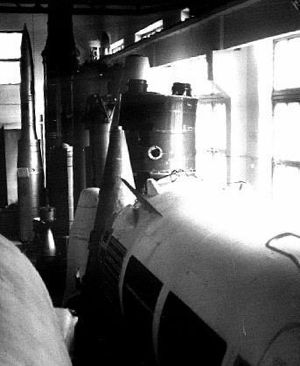
Home - Search - Browse - Alphabetic Index: 0- 1- 2- 3- 4- 5- 6- 7- 8- 9
A- B- C- D- E- F- G- H- I- J- K- L- M- N- O- P- Q- R- S- T- U- V- W- X- Y- Z
Gnom

Gnom Launch Profile
Credit: © Mark Wade
Status: Cancelled 1965. Payload: 535 kg (1,179 lb). Gross mass: 39,000 kg (85,000 lb). Height: 16.14 m (52.95 ft). Diameter: 2.60 m (8.50 ft).
Boris Shavyrin of the Kolomna Bureau of Machine Industry (KBM) led the development team, which included the TsIAM and TsAGI enterprises. KBM itself had experience in developing solid propellant rockets for small surface-to-air missile applications. From the beginning of the missile race the Soviet Union recognized the ultimate ICBM would be a quick-response land-mobile weapon. A tracked vehicle with a weight under 60 metric tons, including a rocket under 30 metric tons, would allow the missiles to be moved continuously. This would negate the ability of the United States to target fixed launchers using its formidable reconnaissance assets. This in turn would free the Soviet Union from a knock-out first-strike by the US Strategic Air Command.
Decree 708-336 of the Soviet Ministers of 2 July 1958 requested several design bureaus to begin work on such a missile. These included Korolev, Makeyev, Tyurin, Tsirulnikov and Yangel. However conventional liquid or solid propellant rocket designs of the period did not have the performance to meet the weight requirement. This work was formally closed out by decree SM 138-48 of 5 February 1960. However Boris Shavyrin, then involved in the development of the D-6 SLBM of TsKB-7 Arsenal in Leningrad, had proposed an innovative alternative. This caught the attention of missile chief Ustinov, who put Shavyrin in charge of a new special project group at KBM. Their objective was to develop an ICBM using Shavyrin's unique solid-fuel, vertical air-augmented engine (VRD). Such a rocket would have double the propellant performance and lighter construction than a conventional rocket. Calculations indicated that the entire land-mobile system could indeed be fitted on a tracked transporter with a total system weight of under 60 metric tons. A silo-based variant was also planned.
The concept was evidently been proved on a subscale tactical missile, the PR-90, now on display at MAI's museum at Orevo, north of Moscow. The PR-90, with a launch mass of only 1500 kg, of which 550 kg was payload, could reach an altitude of 40 km and a range of 100 km. The booster unit used 200 kg of RAM-10 ballistite with a specific impulse of 180 seconds to get the missile up to ram-air ignition speed. Then the air-augmented unit, with a specific impulse of 550 seconds, cut in and used 300 kg of propellant to boost the vehicle to its 1 km/s cut-off speed. An equivalent liquid propellant missile (such as the American Lance) weighed over twice as much. A solid propellant equivalent (such as the French Pluton) would weigh three times more.
The first concept for the full-scale missile used the solid propellant first stage designed by Yangel for the RT-20P / 8K99. But as the design progressed this was found to be too limiting and a new design booster was envisaged. The final project design was for a mid-sized rocket with a total mass of only 29 metric tons.
Shavyrin died at the end of 1965. Only days after his death, the first test of the direct-flow VRD engine took place at Turayev. The engine demonstrated a maximum air flow of 1200 kg/sec. However Shavyrin's death sealed the fate of the project, which was cancelled before 1965 was out. It would not be until the 1990's that Russia fielded a mobile ICBM (and even then the rocket mass was 47 metric tons). The Gnom also represented the most advanced work ever done on an air-augmented rocket. Several US companies had studied similar approaches in a conceptual basis in the early 1960's, but any experimental work was quite limited (for example Martin calculated in 1962 that the use of their Rocket Engine Nozzle Ejector system on the first stage of an orbital launcher would reduce total vehicle lift-off mass by 56% for the same net payload).
The Gnom was a three-stage rocket with a 'zero' booster assembly built as an integral part of the first stage. The four-chamber booster was arranged around the outside of the primary vehicle. The booster took the vehicle to Mach 1.75, at which point the first stage's direct flow VRD cut in. This accelerated the vehicle on an optimum aerodynamic trajectory, reaching Mach 5.5 within 60 to 70 seconds. After this the conventional solid propellant second and third stages took the 535 kg one-megaton warhead to near-orbital speeds.
The VRD first stage propellant was developed by Nikolai Silin at NII PKh and delivered the phenomenal air-augmented specific impulse of 550 seconds, double that of a conventional rocket. The booster was built by Yakhov Savchenko at ANII KhT. The second and third stages were by Boris Zhukov at NII-125.
The rocket was cold launched by a powder gas cartridge. Once clear of the launcher the booster ignited. The air flow was constrained by the container halves, which connected with the nozzle of the VRD. The body of the VRD nozzle was an integral part of the structure of the container.
Had the design reached production, it was planned to deploy ten reloadable self-propelled launchers for the missile. These were based on the KB-3 heavy tank chassis of the Leningrad Kirov Factory, Zhosef Kotin, Chief Designer. The silo for the fixed-position version was designed by Yevgeni Rudyak at TsKB-34. NII-108 would have produced the missile countermeasures, and Ilya Pogozhev at TsNII AG was responsible for the inertial navigation system. Flight models would have had a composite material body.
The 29 metric ton missile was designed as a sealed unit for quick-reaction firing over an 11,000 km range at any time during its ten year guaranteed storage life.
| PR-90 Russian short range ballistic missile. Short-range air-augmented ballistic missile. Tested concepts for Gnom ICBM. |
Family: ICBM. Country: Russia. Agency: Makeyev bureau. Bibliography: 475, 476.
 | Gnom Launcher The Gnom missile in the erected position on its KB-3-derived tracked launcher. |
 | PR-90 Credit: © Mark Wade |
 | Shavyrin |
 | Gnom Gnom transporter in mobile (left) and launch-ready (right) positions. Credit: © Mark Wade |
 | Solid rockets, Orevo Solid rockets at Orevo 4 Credit: © Mark Wade |
Back to top of page
Home - Search - Browse - Alphabetic Index: 0- 1- 2- 3- 4- 5- 6- 7- 8- 9
A- B- C- D- E- F- G- H- I- J- K- L- M- N- O- P- Q- R- S- T- U- V- W- X- Y- Z
© 1997-2019 Mark Wade - Contact
© / Conditions for Use